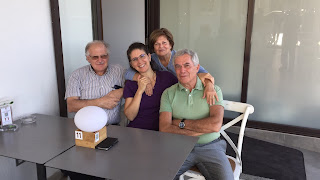In these difficult times, I was able nonetheless to steal a few days to go see my aunt, zia Clelia, in beautiful Sicily. I managed this incredible trip just before Italy closed most of its activities: concerts, restaurants, limited travelling...
It is the middle of October but I was able to swim, EVERY MORNING!
We stayed with my dad's cousin in the little village of Furci Siculo, just South of Messina and from there, we took little trips to the nearby villages.
 |
| This is us swimming |
One of the first trips was to Forza D'Agrò, which is just South of Furci and can be seen from the beach where we were swimming every day:
 |
| The Castle of Sant'Alessio, can be seen on the far right. Just above it, we visited Forza D'Agrò |
The next day, we visited Savoca, a small town on the top of the next hill.
It is a much better known - and more turistic - little town thanks to Francis Ford Coppola, who, in 1972, shot several scenes of the Godfather here. It is here that Michael Corleone (Al Pacino) met the beautiful Apollonia Vitelli, asked her hand to her father at the Bar Vitelli, and then married her at the local church. The town was relatively untouched and therefore the perfect set for the town of Corleone.
This is the Bar Vitelli, still called like this. I believe the owners are actually called Vitelli in their "real life"! There was a beautiful vine, changing colours, and offering shade to the very few visitors.
We then took a stroll to see the church of San Lucia where the wedding took place. The town is perched on two adjacent hill tops, so you walk on two narrow roads (one way each) from which you have the most incredible view: of Mount Etna on one side...
This is a particular of the rosette of the cathedral:
 |
| This is our fabulous movie maker, Vincenzo Nicita Mauro! |
 |
| zia Clelia getting ready with Pippo |
We were actually waiting for a little while for the colourful little boat in the background to leave the harbour, since it turned on its engine and its noise was covering any sound we could ever produce. We had set our stage right there because of this very colourful boat. We melted in the sun a little, and then it finally left.
At the end, we rewarded ourselves with a refreshing granita al gelso (you see a gelso sitting above the granita. It is not a blackberry, but juicier and it grows on a tree!)
On the last day, I was surprised by being offered a ticket to a concert - alas, one of the last ones for a while - from a friend of my uncle, who kindly gave me her seat once we discovered that the concert featured Bruno Canino and Antonio Ballista! The piano duo is an Italian institution, equal to the Ferrari and the Teatro La Scala, celebrating their 60th year together. The duo supported and premiered much of the piano duo repertoire in Italy and in the world, spanning from work in Darmstadt, to premiering Berio's Concerto, written for them and premiered with the New York Philharmonic conducted by Boulez! Bringing to the stages of the world music by Dallapiccola, Donatoni, Ligeti, Boulez, Cage...together, of course, with the more traditional repertoire. And, in fact, they performed Liszt's transcription for two pianos of Beethoven's 9th symphony. Maestro Canino, now about 85 years old, but cheerful and kind as always, was also my teacher more than 20 years ago, and it was a very toucing surprise to find him there and being able to talk briefly afterwards.
A musical highlight to end a wonderful trip, is this Paradise?






















































